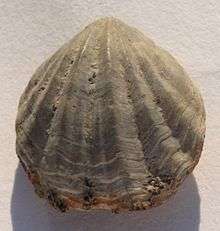Sandy Hook Formation
| Sandy Hook Formation Stratigraphic range: Maastrichtian ~66.0–72.1 Ma | |
|---|---|
 An Choristothyris plicata, lampshell, collected at Navesink Formation, near Poricy Brook, New York | |
| Type | Geological formation |
| Underlies | Navesink Formation |
| Overlies | Mount Laurel Formation |
| Area | 100 miles (160 km) then an additional 100 fathoms (180 m) into the Atlantic Ocean[1] |
| Lithology | |
| Primary | Sand, quartz, massive, dark-gray, fossiliferous, feldspar, muscovite, chlorite, and biotite are minor sand constituents |
| Location | |
| Coordinates | 40°23′58″N 73°58′36″W / 40.399429°N 73.976639°W |
| Region | Atlantic coastal plain of the Coastal Province of North America |
| Country | United States |
| Extent | Monmouth County, New Jersey |
| Type section | |
| Named for | Sandy Hook, New Jersey |
| Location | Sandy Hook, New Jersey |
| Coordinates | 40°24′N 74°00′W / 40.4°N 74.0°W |
| Approximate paleocoordinates | 40°36′N 49°30′W / 40.6°N 49.5°W |
| Region | New Jersey |
| Country | United States |
| Thickness at type section | up to 40 feet (10 m) |
The Sandy Hook Formation is a geologic formation in New Jersey. It preserves fossils dating back to the Cretaceous period.
See also
References
- ↑ "Sandy Hook Bay, New Jersey Coastal Storm Risk Management Feasibility Study" (PDF). March 2015. pp. 17–18. Retrieved 6 September 2016.
- Various Contributors to the Paleobiology Database. "Fossilworks: Gateway to the Paleobiology Database". Retrieved 22 June 2014.
This article is issued from Wikipedia - version of the 9/7/2016. The text is available under the Creative Commons Attribution/Share Alike but additional terms may apply for the media files.